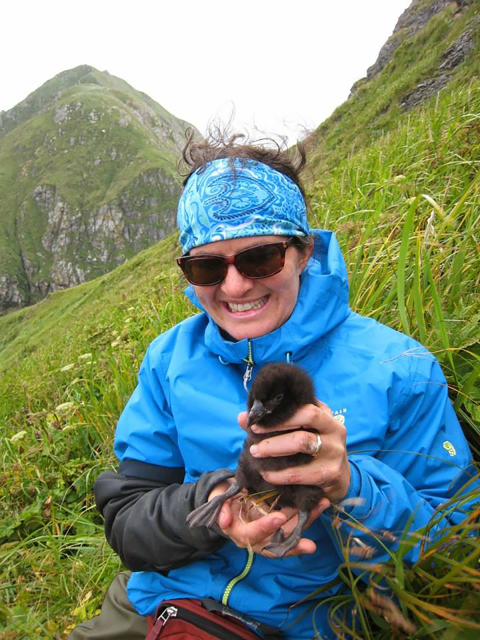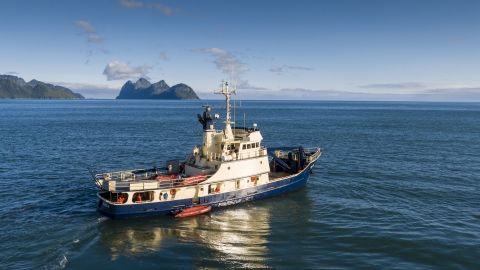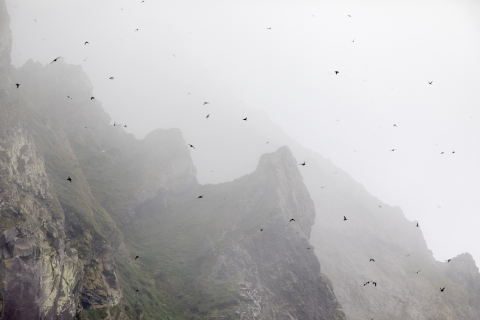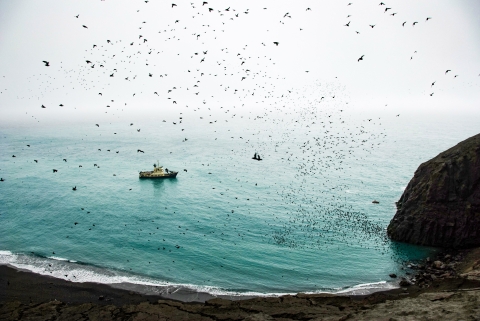In Alaska, the U.S. Fish & Wildlife Service employs a small army of dedicated and passionate staff with a large spectrum of roots. Some were born and raised in Alaska. Others have come from around the world. Regardless, some stay to do a job they feel is important enough to spend a lifetime doing. Heather Renner, an Alaska born biologist talks about her time work in Alaska.
What do you do for the U.S. Fish and Wildlife Service?
I'm the Supervisory Wildlife Biologist at the Alaska Maritime National Wildlife Refuge, and I'm in Homer, Alaska. I've been here, at Homer with Alaska Maritime Refuge for 24 years, which makes me feel old. When I came, I was still somewhat young. I went out and I spent my first summer on a remote island in the western Aleutians. I came back and came to a staff meeting and with great delight, I announced that my supervisor had been working on that island the year I was born. I thought that was hilarious that he was that old. That was 24 years ago. We often hire folks about that age now. So I think that's about to happen to me next.
Where are you from?
I was born and raised in Anchorage; I was lucky to grow up with parents that made wildlife and nature a part of everything we did, as adventures and, and we just spent all of our time in the outdoors. So I grew up hiking and sea kayaking and back country skiing. That made me really love Alaska's wild places. I grew up getting to see a lot of them as a firsthand observer and fell in love with Alaska.
How did you start your work with the U.S. Fish and Wildlife Service?
When I was 15, I got a job at the genetics lab in the regional office in Anchorage. A lot of what I did was washing dishes and data entry, but I had an amazing mentor. I was immediately introduced to the theory of genetics and exposed to the great people that worked on that. I also that year, got my first taste of field work. And I got to go fly in a helicopter to collect genetic samples out on Yukon Delta National Wildlife Refuge. It was honestly sheer luck. When I was 14, I worked in a day camp and environmental education camp. The older counselor that I worked with recommended it as a place where he knew that sometimes younger people had been hired to work in the lab. So, I called them up and was told that there were no positions available. I kept calling and kept being told that there were no positions available. And eventually, I decided I was taking a marine biology class at school that year, and I decided since I learned what electrophoresis was so that I could call and sound interested in the job that I might as well do a project on it. So, I decided to do a marine biology project in that lab, and I called back, and I asked if I could come in and take a tour for my high school class. I did that. After a while a woman at the lab decided to offer me a position. She called me and said, we like you, you're persistent. So that was how I got my foot in the door. After that, it just got easier and easier. I was hooked. After that I was involved in what's now called the Pathways Program. At that time, it was called the SCEP program. When I graduated from college, I had a permanent job offer. And I went and spent three years out in King Salmon working at the Alaska Peninsula National Wildlife Refuge, until I worked as a kind of entry level career biologist out there for three years. Then after that, I left and went back to graduate school. When I finished my master's degree, I again had an opportunity for a permanent job. That brought me to Alaska Maritime National Wildlife Refuge in Homer. I've been here ever since.
How big is the Alaska Maritime National Wildlife Refuge?
The refuge is really hard to wrap your head around. It's 1000s of islands over the entire coast of Alaska. So, all the way from Southeast Alaska to the Gulf, and then most of our land mass is in the Aleutian chain. We also have islands up in the Bering Sea and all the way up into the Chukchi and the North Slope of Alaska. So, it's really far flung islands that are in rain forest and maritime tundra, and then all the way up to really arctic regions up north. If you put Alaska Maritime refuge on a map of the lower 48, it ranges from Georgia to Texas to California and all the way up to Minnesota. And it really takes I feel like it takes five or seven years before you have enough of a feel for the place that you can remember where all the islands are located and that they make sense to you in your head. After 24 years, I've been to a whole bunch of islands but nowhere near the majority of them. There is always a sense of adventure, but you do start to get a feel for the different eco-systems.
What kind of work do you do on the Refuge?
Very little of it is near Homer where we're headquartered. So, we don't get to see it year-round and it takes quite a bit of extended travel to get to see it. You can rarely make a day trip to go see the refuge unless you're somebody lucky enough to live closer to it than most of us staff do. So, we visit it mostly by our research vessel, the Tiĝlax̂ (TEKH-lah - Unangam Tunuu or Aleut for eagle). We make trips that have roughly a minimum of two weeks and our luckiest employees get to spend their full summer out on the islands that are part of the Alaska Maritime Refuge. Most of my time is spent thinking about our long-term seabird monitoring program, we have data sets that have been collected for approaching 50 years at many of our sites. We collect the same type of data on a variety of species at all of these sites. We have different biologists that are in charge of each of the specific projects. But my role is to kind of put all that together and make sure we're thinking about things with a landscape view. Well, it turns out for ecological questions for long-term monitoring, it takes about 30 years in the data set before you can start to investigate relationships with environmental change. So you have to have tremendously long data sets before you can ask questions about sea temperature, or sea ice change, or some of these other climate effects are they causing the changes we're seeing in the sea birds that we keep track of? The most effective tool we have is selecting some very simple monitoring metrics and collecting them exactly the same way through a long period of time. It turns out, that sounds simple, but it's really hard. It's hard to have things that are simple enough that you can be sure that other people will interpret them and do them the same way over long periods. And the technology changes will not change your methods enough that you're collecting different data with different ways.
What are some long-term projects you have going on?
We have eight long-term sites where we spend a lot more time and each of them are incredibly unique and special and they were picked because they are important seabird colonies. Many of them have millions of seabirds nesting on them. And they're really wildlife spectacles that you can experience differently by day and by night. Some of them might have a million thick-billed murres cooing and others might have one or five million auklets that you see, at different times of the day. It's just a bustling swirl of wildlife. At other times of day, they're all at home, in their underground rock crevices and you wouldn't have any idea that anybody's there.
How has field work changed over the years?
Our field crews spend three or four months at a time on a remote island. And often the only contact with humans that they'll have is their camp mate who may just be one or two other people that they're living with. Until about 2000-2001, all of the communication they had was by single sideband radio. We have an office in Adak, in the central Aleutians. That's our communications hub. Twice a day, folks would get weather reports in the morning and check in in the evening to make sure everybody was back safely from activities and to share news of what's going on in the camps and to share news to the campers of what's going on in the world. Sometimes those radio communications would be fun games, we played radio Jeopardy to boost the morale of our campers that had been on the island for months. Often, they were exchanges of scientific information. There's a day usually once a summer when the ship comes and brings mail. And that day nobody's thinking about their island. They're all kind of lost in home and packages come and letters. That day's kind of a write off for the field season, but it's one of everybody's favorite days. But there's a little bit of a relief when you get back to your island and your own sense of normalcy and what's happening. I spent the summer of 2001 on Buldir in the western Aleutians and I have been out there for four months with a small crew. We were picked up by our research vessel and brought back. The plan was to fly back from Dutch Harbor, back to home. We had heard no news all summer. We had only had occasional satellite phone information from family, and we pulled into the harbor, Dutch Harbor on the morning of September 11, 2001. Turn on the radio. All the news in the wheelhouse was about the attacks that were happening on September 11th. That was our first news after four months, to come back to. It was really dramatic. We pulled into the harbor and ended up getting off and spending the next week in a hotel room trying to get home. To come back from a summer of all those months on this really special island with 4 million seabirds, and no news. And to arrive to that news and the rest of the world was an experience I'll never forget.
What is field work like?
It's not for everybody. To be in one of our camps means you don't have a refrigerator. We bring mostly nonperishable food. Although, we've learned that things like cabbages and onions and apples and carrots keep well, and if you keep them out of direct light and keep them relatively dry, they last for much of the summer. We learn to shower with solar showers. Sometimes folks learn about native plants and are able to supplement their diet a little bit, but it's definitely a life with the land. It's not for everybody. It takes a certain kind of person to love spending months on a remote, windy, foggy, cold, desolate Island, smelling and hearing seabirds 20 hours a day. Starting around 2000, we got satellite phones in our camps. It's meant that we could call home and we could share information that made our lives a lot easier, but it also has changed the feeling of being in a camp when you can get news from your family. It's harder, now that I have little kids. I'm really grateful that when I go into remote places, I can hear from them and talk to them and be a little bit part of their lives. It makes it harder too when they can tell me what I'm missing, and it takes me away from the wildlife refuge that I'm there to experience. My husband's also a field biologist; he did his PhD on the island in the western Aleutians where we met. So that's been lucky. He understands my love for the islands and for seabirds and so he can help out and understand why I have to sometimes go away for weeks or months.
It's an added challenge as a mom, trying to balance your love for the Refuge and your need to be there to take care of your family. The wildlife on the Alaska Maritime Refuge doesn't care if we're there to observe it. Our efforts are to understand what's happening on the refuge. Help us figure out which pieces we may be able to do something about if there's change. Sometimes it's human-caused and sometimes it's not. Often, it's broad scale and maybe beyond our control, but sometimes it isn't. So our job is to bring to the rest of the world this special place that few people get to see and help raise the flag when any of those species are in trouble and help figure out which pieces we may be able to do something about and hopefully leave the refuge a slightly better place.
Adapted from episode 6 of the My Life, Wildlife Podcast!
In Alaska, the employees of the U.S. Fish and Wildlife Service are shared stewards of world renowned natural resources, and our nation's last true wild places. The lands and waters of this place we call home, nourish a vast and unique array of fish, wildlife and people. Our hope is that each generation has the opportunity to live with live from discover, and enjoy the wildness of this odd inspiring land and the people who love and depend on it.
Follow us: Facebook Twitter Medium
Subscribe to My Life, Wildlife! On Apple or wherever you get your podcast









